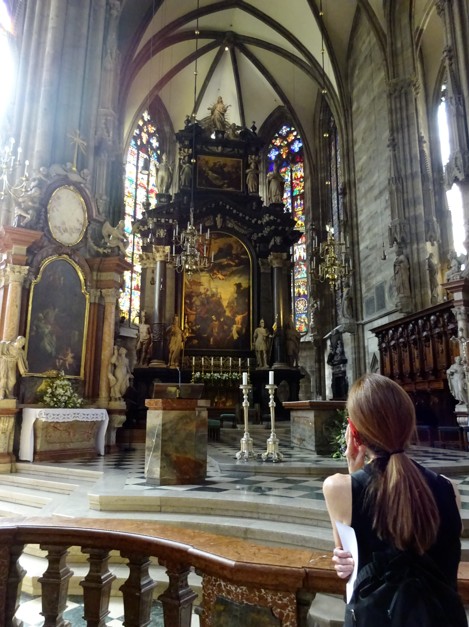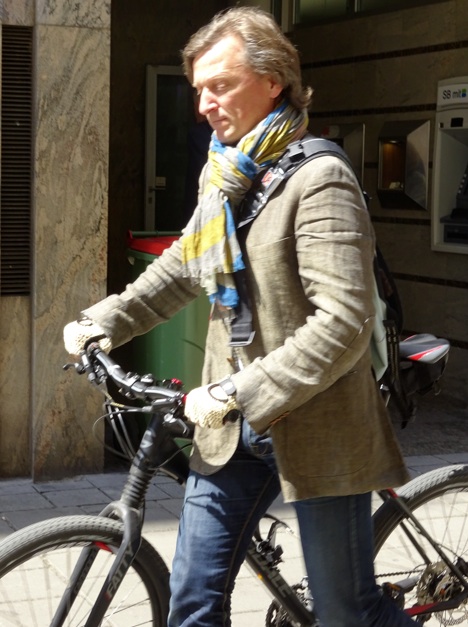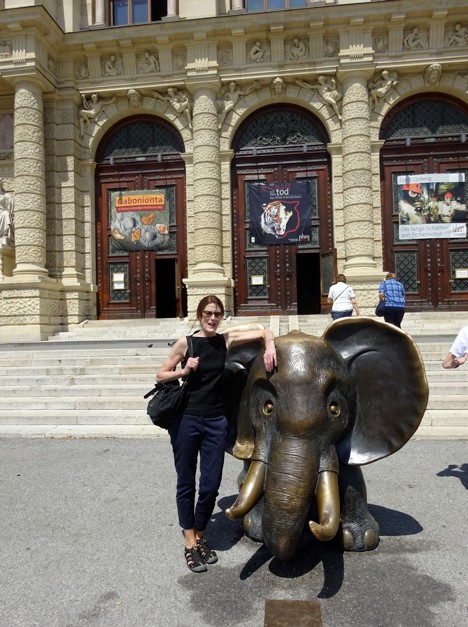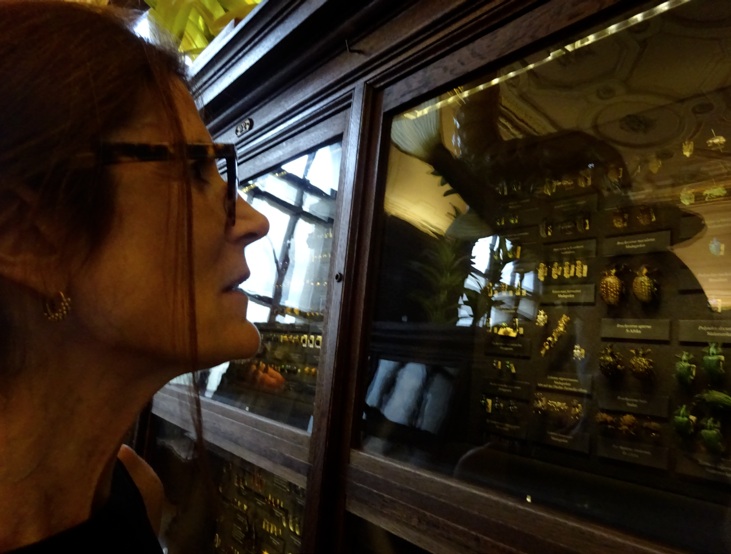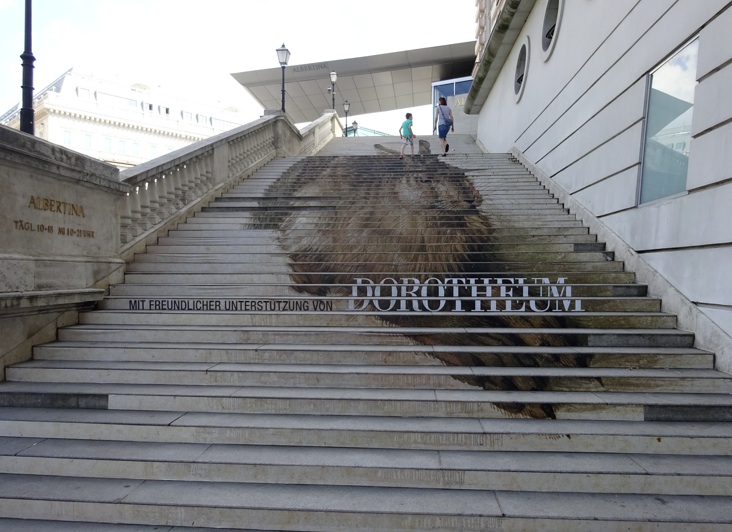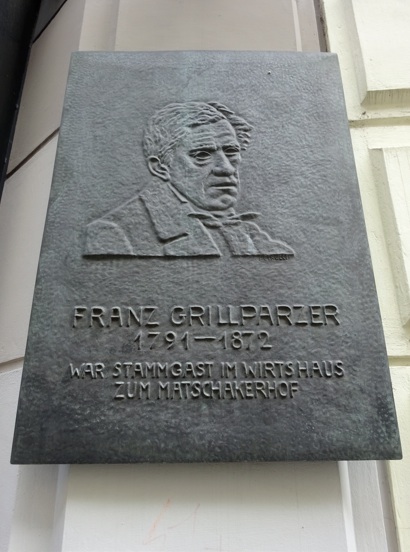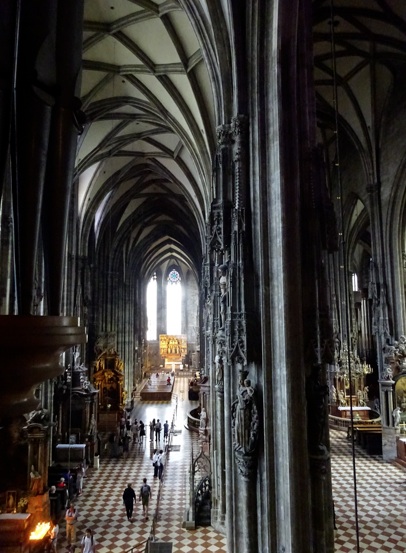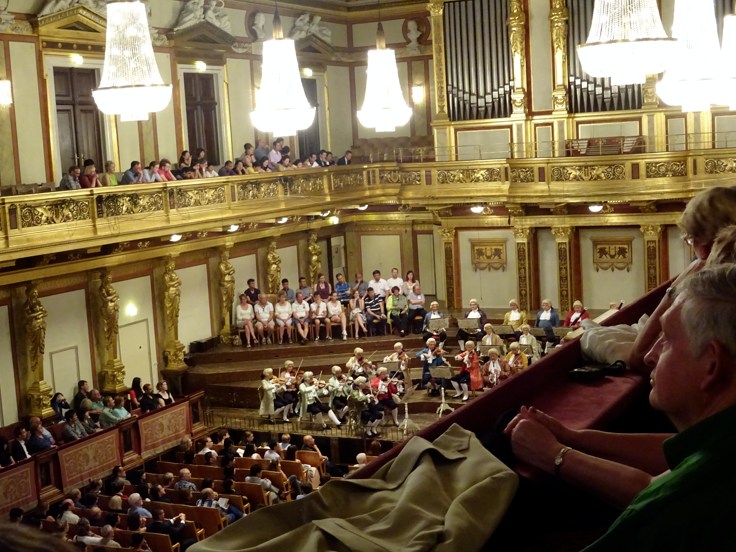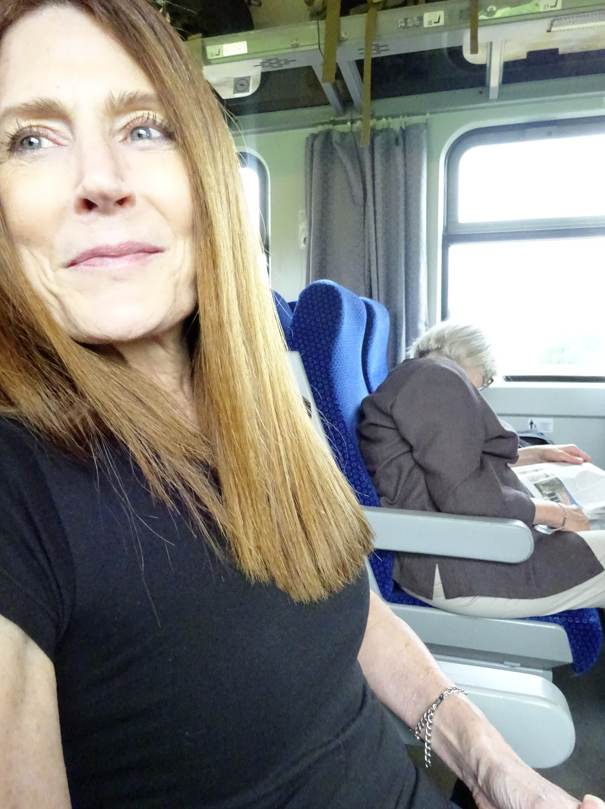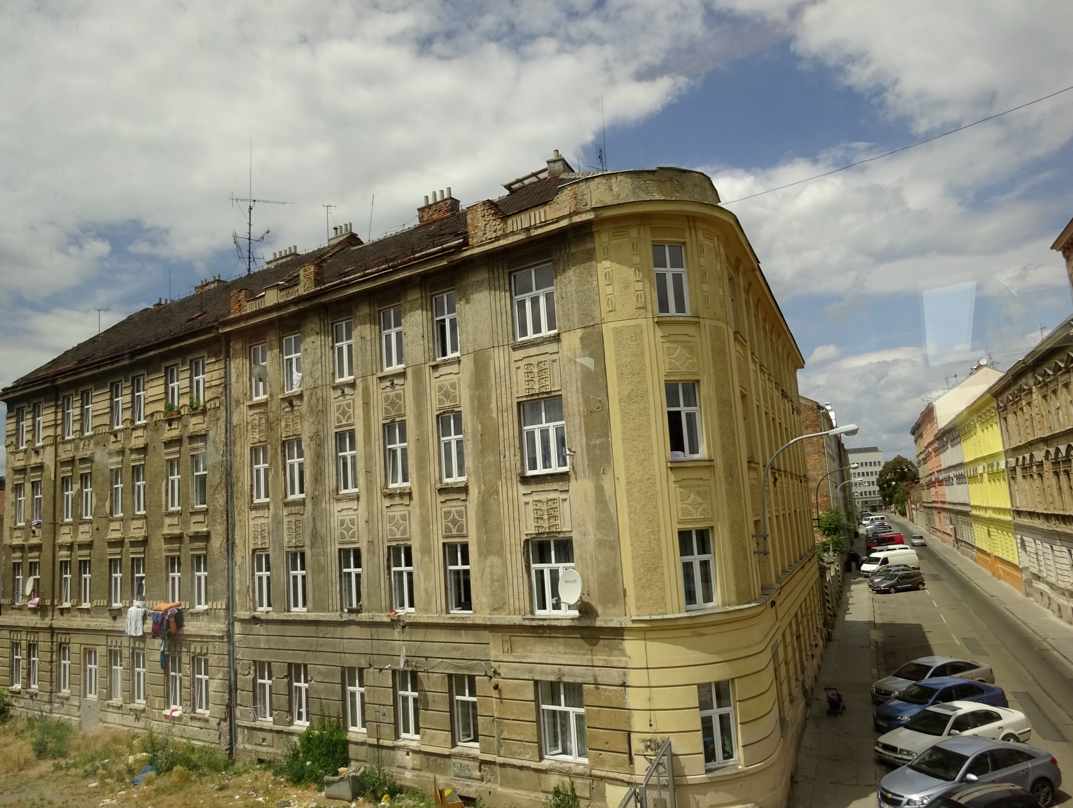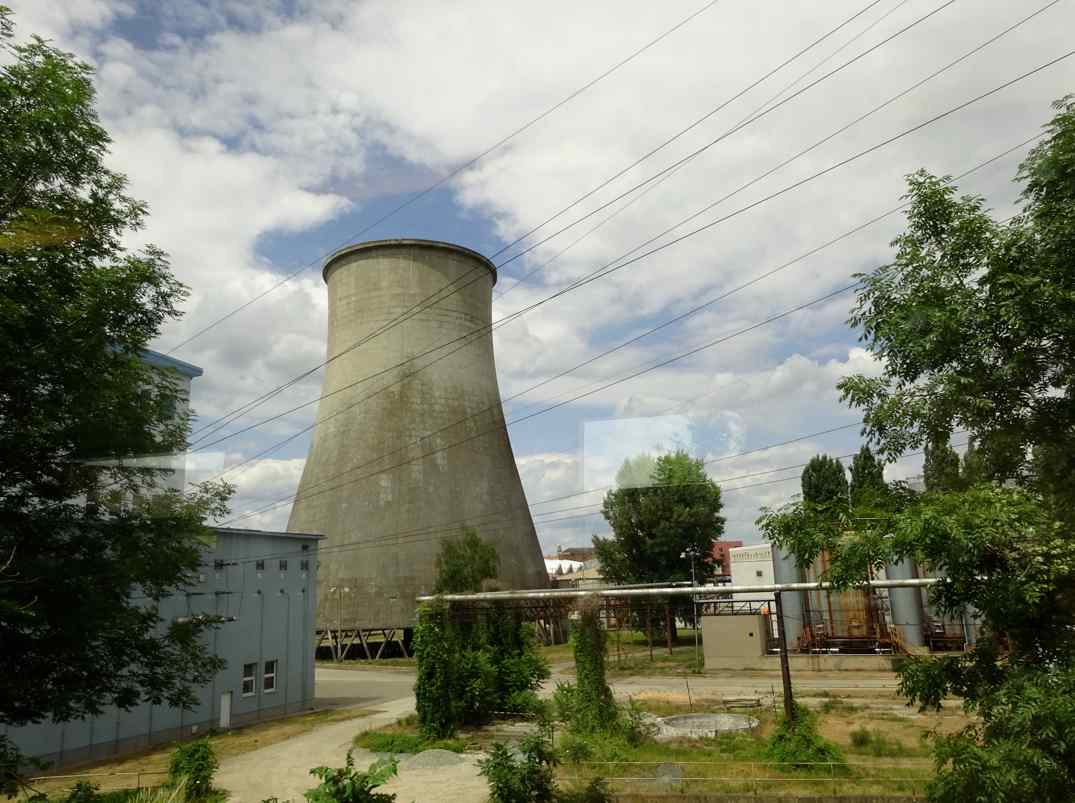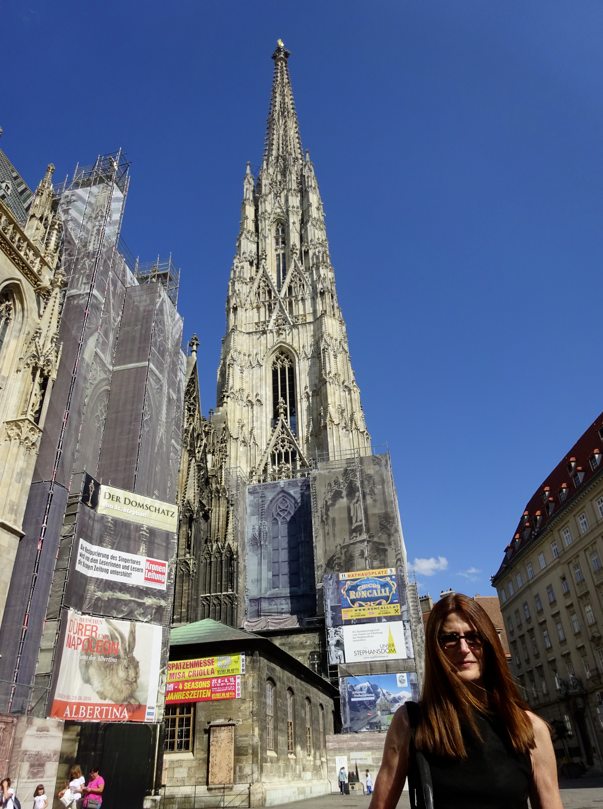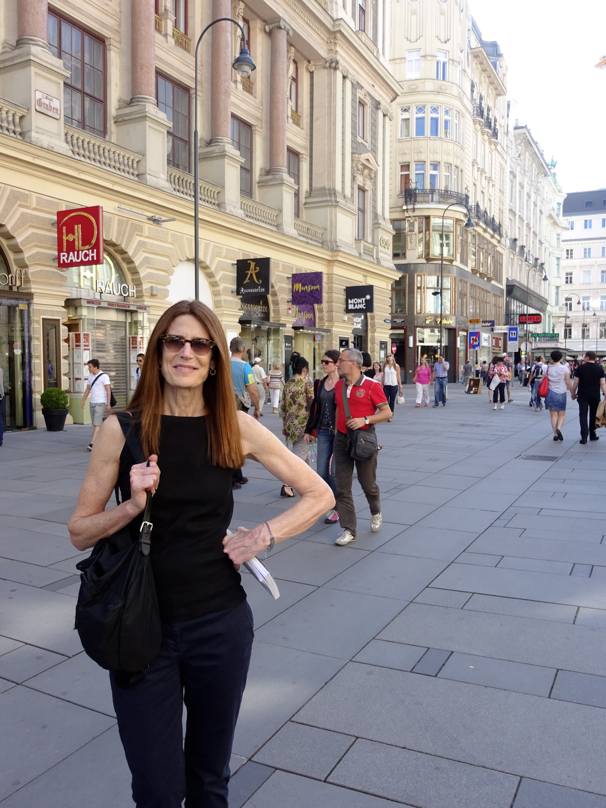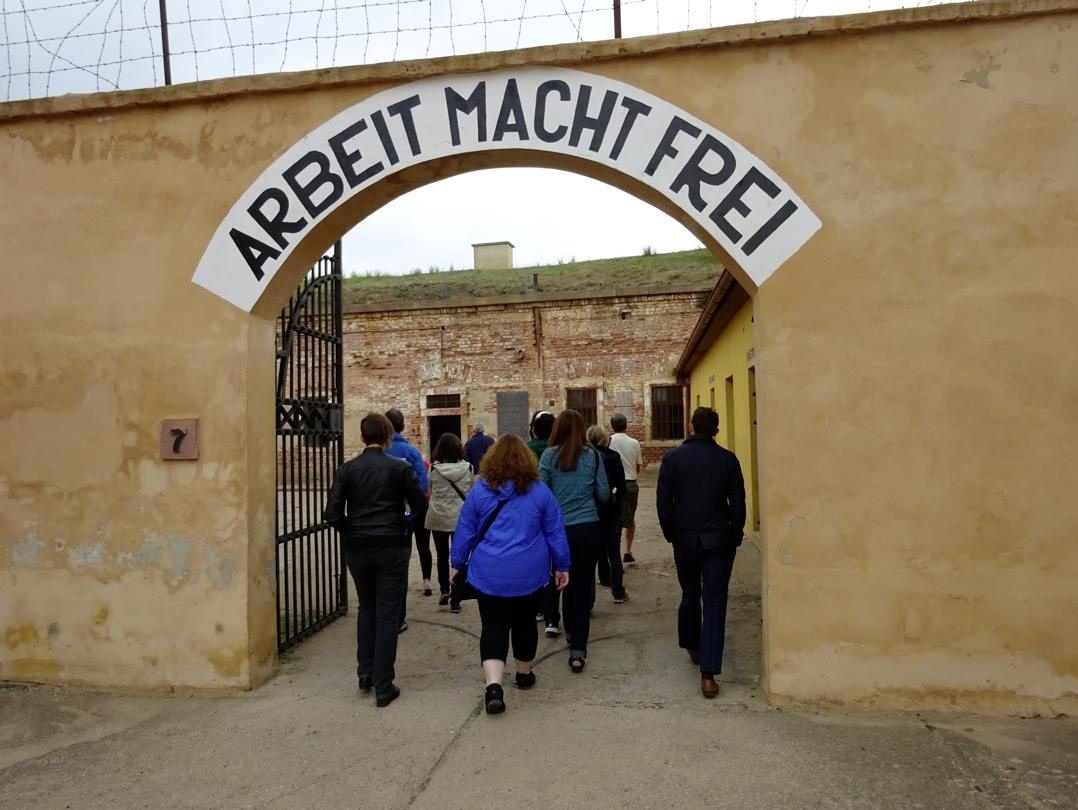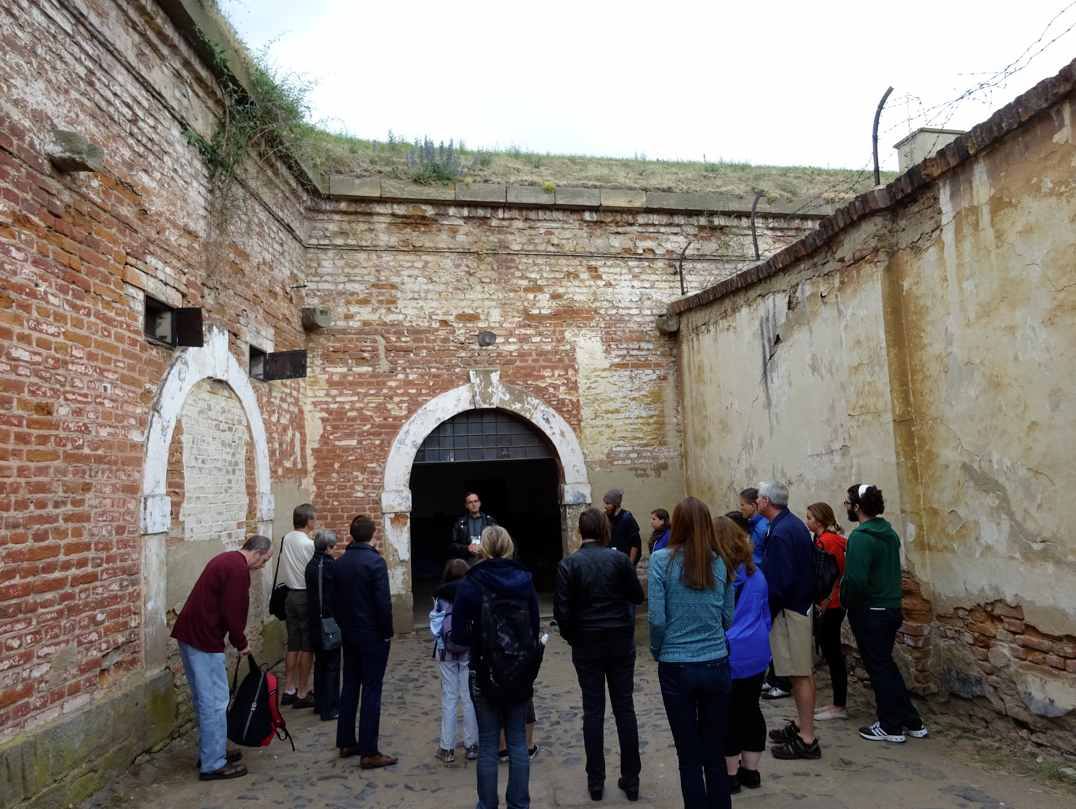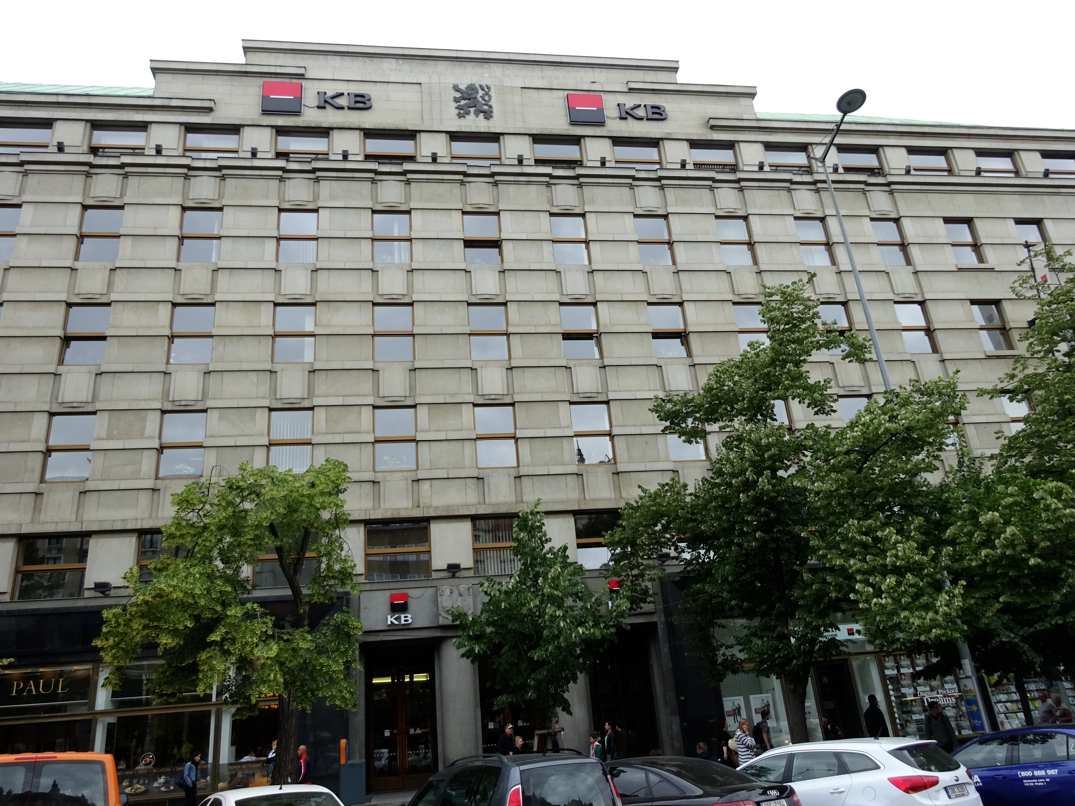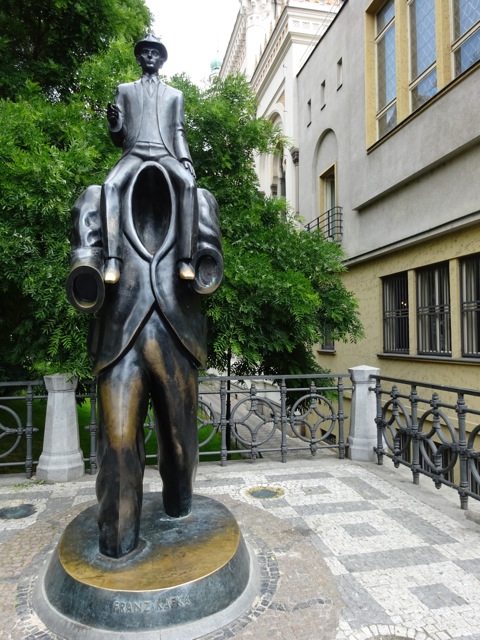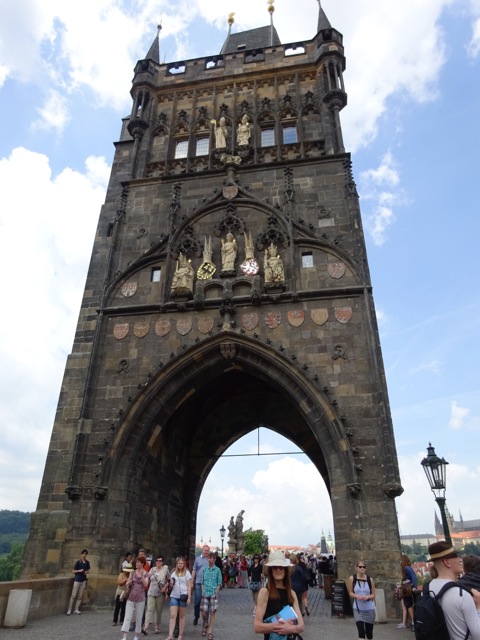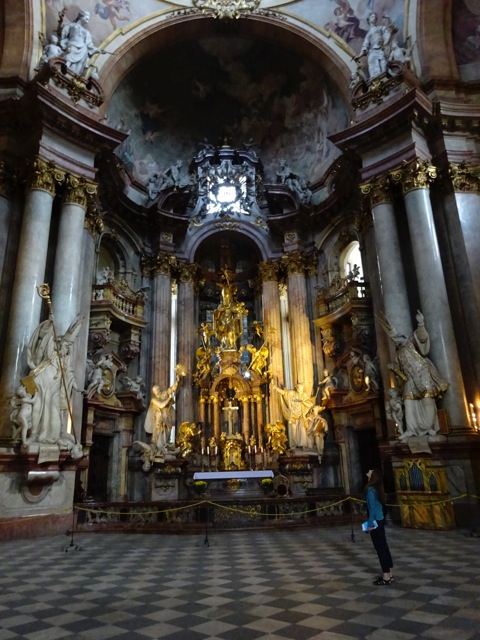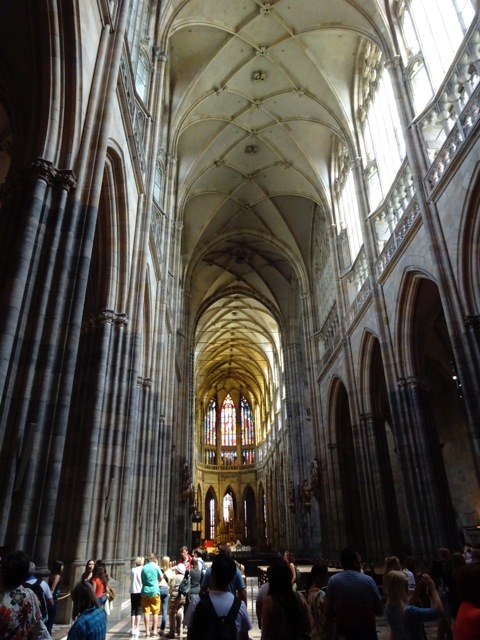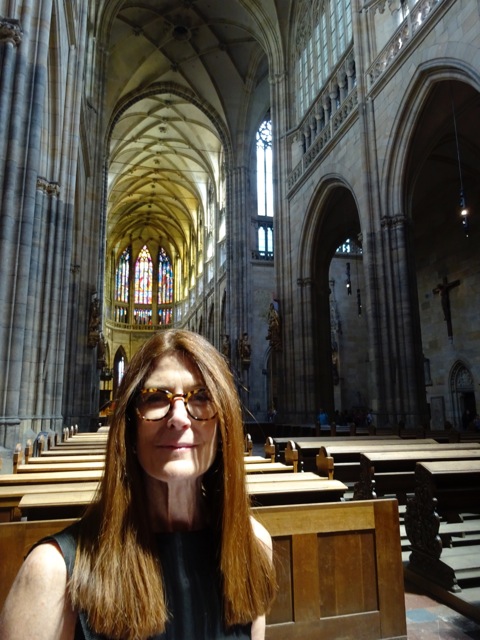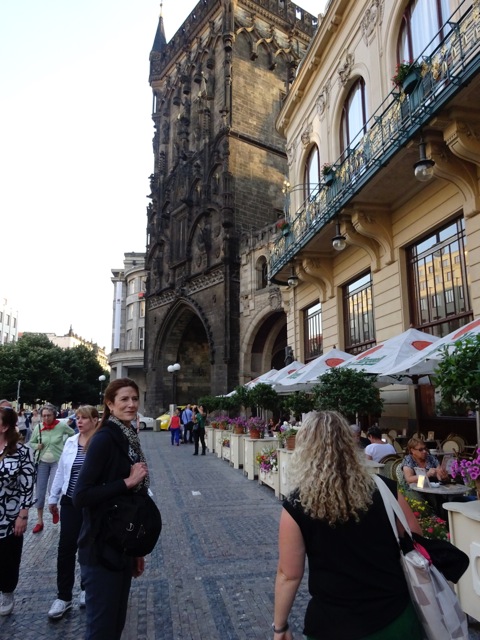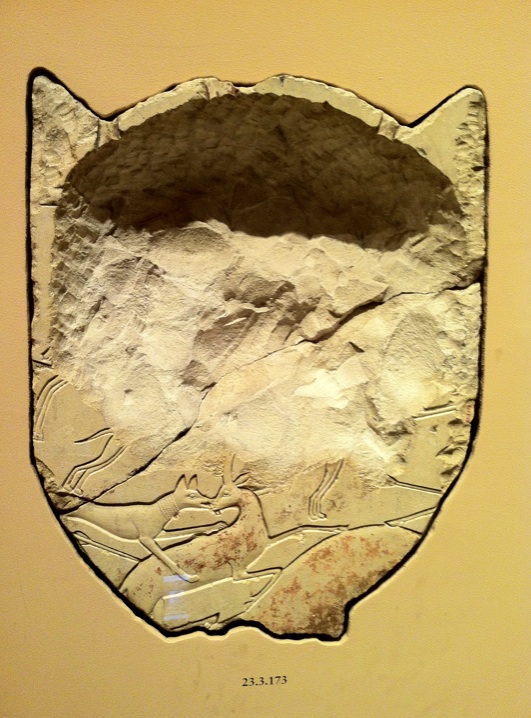Travels posts
Friday August 01, 2014
Eurotrip 2014: Stephansdom, Ringstrasse, Naturhistorisches, Gasthaus
I’ll confess: This was the first trip I felt old. Not because I couldn’t walk the walk but because I couldn’t read the map. The guidebook maps in particular. I’d look at them, blink, pull the book away, try to adjust to the proper range. “Hey, they made this print too small. They need to ...” Then the other shoe. “Oh. Shit.” I went through the three stages of farsightedness: annoyance, realization, acceptance. Will scope out readers soon. Because carrying around two pairs of glasses just isn’t enough.
The Pension Neuer Markt, where we stayed in Vienna, and which always made me think of John Irving’s Pension Grillparzer—but without the bear and with a much better bathtub—offered, as had the Hotel Meteor in Prague, a breakfast buffet, in a cramped but elegant (but slightly frayed) dining area. We ate there every morning, and every morning when we returned to our room it had been cleaned. I assume, when we ordered coffee and they asked for our room number, that they relayed this information to the cleaning service, who went to work. However they did it, it felt efficient.
We were efficient on our first full day in Vienna. We shot the works at Stephansdom: bought the pass for the audioguide, catacombs, south tower, north tower and treasure. I did it all but the north tower, while P traded catacombs for art later in the day. How old is Stephansdom? Work began on it in 1304—or 188 years before Columbus sailed to America. Think about that. When Mozart was married at Stephansdom, when he lived a block away, it was already, at that time, nearly 500 years old.
After the audioguide tour and the south tower climb, fighting for space in the narrow stone stairs with hordes of kids on field trips, we ran into different versions of Wolfgang Amadeus selling opera tickets along the Stephansplatz. After our great experience at the Municipal House in Prague, we were interested in hearing music again, so I bought a pair of cheap tickets from a short, fat Mozart for about as much as it cost to shoot the works at Stephansdom. It was just money, right? Euros. Like play money. You just spend it. It’s there to be spent. The bill arrived recently. Oops.
Since we missed the #22 tram in Prague, P was interested in taking the Red City bus tour along the Ringstrasse to get a better overview of the city, which we did, meeting, along the way, a ticket seller from Spain, who admitted he wasn’t a big fan of German food. But the place across the street, he said, was good. We remembered the location more than the name: Plachutta: Gasthuas zur Oper.
We had no Wenceslases on this tour, just an audio guide, as we sat in the sun on the top deck of the bus. We didn’t stay long. Patricia, with a penchant for taxidermy, had us get off at the Naturhistorisches Museum, with its small elephant statue in front and a Noah’s Ark full of stuffed and mounted animals inside. The hallway was cavernous, the exhibits never-ending, Patricia in heaven. It was also fairly empty of tourists. Most people don’t go to Vienna for the taxidermy. But you could tell, 100 years ago, that this was the thing to do: to collect and preserve different and exotic species for display for the masses. Back then, the exotic was natural and from some far-flung place on the globe. Now it’s some two-dimensional phantasm, occasionally with 3-D glasses.. We also saw a good, frightening exhibit on “The Long Shadow of Chernobyl.”
After lunch at the museum, and the remainder of the Ringstrasse tour (there’s a Franz Grillparzer Street!), we wanted coffee, so stopped at the outdoor Mozart Café of the Sacher Hotel. P had talked all day about getting a Sachertorte, which, to my non-foodie ears, sounded like “soccer torte.” It was fine but not something to travel to Vienna for. Meanwhile, I wanted a simple iced coffee but wound up with some distinctly Viennese concoction. It rose up in the glass, impossibly white and fluffy, with various cookies stuck into it. If I must.
Traveling together as a couple is a bit of a test. You wake up together, eat together, plan together, walk together, visit the same things together, eat together again. For dinner one night, we sat down, looked over the menu, ordered, looked at each other. Silence. Finally I broke it. “So how was your day?” I asked. That’s why it’s always a good idea to split up every now and again, which we did that afternoon. P wanted to see the Durer exhibit at the Albertina, and I walked her there. Of course, us being us, we got lost. We walked as far as the Hofburg before she realized her mistake and backtracked. I stuck around there, though, basically kicking stones and taking pictures and going my own way.
Ten minutes later my phone rang—my first call in Europe! Patricia, of course. She said I just had to see the steps at the Albertina. Plus, right next to the Albertina, was a museum to film, which I needed to check out, too. So I walked over, saw Durer’s rabbit painted on the steps, entered the sedate Film Museum. But the name was a misnomer. It was basically a movie theater that showed art films in the evenings. The good news? On the way back to Stephansdom I saw a relief of Franz Grillparzer. See slideshow below.
It was a hot afternoon and so a tour of the catacombs at Stephansdom sounded like a good idea. An hour later, after spending time walking down cool stone steps in cool hallways and viewing the bones of the victims of centuries-old pestilence, I emerged into Stephansplatz, where P, waiting, was full of stories. Together we toured the Treasures section of St. Stephens, which included many reliquaries, of which P, a good, wayward Catholic girl, was a fan. For dinner, we followed the advice of our Spanish tour guide (the gasthaus near the Opera) and didn’t regret it. I regretted the opera a bit. It wasn’t the national opera, near the gasthaus, but a few blocks further south: “Mostly Mozart.” Crowded and kitschy. They let the tourists on stage, sitting there in their shorts, which P thought a bit gauche. Or at least linke. But the music was good. As in Prague, a lot of “Magic Flute.”
SLIDESHOW
Monday July 21, 2014
Eurotrip 2014: Dekuju, Praha; Tag, Wien
It took me several days to finally remember the Czech for “thank you”: dekuju. The spelling threw me at first, I guess, but it stuck once I realized it was basically like Elmer Fudd saying “decree”: de-KWEE. Hehehehehehe. I also learned “Good morning” in Czech: Dobré ráno. That was it, though. I had an app I planned to use to learn more Czech but it kept crapping out on me. But those two words went a long way in the touristy circles I ran in, even as they were wholly unnecessary, since most folks spoke English. And German. And maybe Russian. Seriously, all of those “Speak English!” folks in the U.S.? They need to get out more. It’s less the number of languages people from other countries speak than the fact that you can go pretty much anywhere in the world and people will speak your language. English is doing just fine, dekuju.
P and I were reluctant to leave Prague yet arrived at the train station more than an hour early—even though the platform wouldn’t be announced until 20 minutes prior to departure. I didn’t know this. I always think earlier the better but here I felt like a rube. While we waited, P bought a coffee and I exchanged most of our korunas for euros. That was an oddity of our trip: We were visiting three countries in Europe, but two of them, the Czech Republic and Switzerland, weren’t on the euro. So we had a lot of exchanges. I spent a lot of times examining small coins. Was this a .... what was this?
Ten minutes before departure, our train platform was finally announced, and the huge, waiting crowd streamed through the tunnel—which includes a small bust of Woodrow Wilson, onetime hope of the world—and scrambled for a seat. We were less insistent since we bought tickets with assigned seats. Of course someone was in them. P spoke to him and the man apologized, moved his stuff, and sat in the seat in front of us. I was confused, though. How many seats were already bought? How could you tell? Were we even in the right place? Later in the trip—Vienna to Geneva—it happened again, but with a less polite deportee, but that time, an hour or so later, I found a conductor, who took a look at our tickets and declared, “You’re in the wrong car.” Wouldn’t be surprised if this was true during the Prague leg, too. Nothing more first-world than that, right? Declaring ownership of a spot you don’t own and booting folks from it. As they apologized for your mistake.
The car from Prague turned out to be the kid car. By which I mean the teenage car. Late teens? A group from ... Spain? I think they were on a second leg of a trip, because they were all tired, and several fell asleep sitting up, and one kid threw up. It was a source of great amusement for the others. Almost forced amusement, to be honest. One of the kids wore a T-shirt reading, I believe:
NO SOY YO
ES LA PERA
“Es la pera” or “Soy la pera” apparently means “I’m the pear,” which apparently means “I’m the shit.” But the rest? Anyone? Bueller?
Five hours later, after rattling past various rolling hills as well as a nuclear reactor in Brno, we arrived at the Wien-Miedling station. We walked down the stairs, took a left, and wound up blinking in the sun. I thought we’d see a train station, or at least a city, but we seemed in the sticks. Has we gotten off in the wrong spot? The Rough Guide to Vienna (also by Rob Humphreys) was a little sketchy on the subject, and I was ready to go back and turn right where we’d turned left, but P was anxious. So we just took a waiting cab to our hotel. Overpaid.
The pension kind of threw us, too. It wasn’t a hotel? With a lobby? It was just a door? We knew what pensions were but some assumptions are hard to break. Instead of a lobby, a heavy door led to a dark hallway, which led to an old-fashioned glass elevator, that you took to the third floor and the Pension Neuer Markt. It was a bit frayed around the edges but otherwise wasn’t bad. We got the key and I thanked the receptionist. Dekuju. I mean ... What is it again? Danke schoen. Thank you, Wayne Newton. Although, for me, in Vienna, I kept thinking of the “By Strauss” number in “An American in Paris.” Danke danke, bitte bitte.
Fifteen minutes to freshen up and then out into the blinding 4 pm sun. We walked a half block and ... boom. St. Stephen’s Cathedral. We laughed, it was so near and so beautiful. P wanted to go in right away but I counseled a walk around the city, saving the Cathedral for the next day. A block away, we tried to get a gelato at a busy store but were too frustrated by the disorganization. As we walked, P kept looking into shops for a new purse. That was her purchasing goal for the trip. Generally, though, she’d come out of the store, wrinkle her nose and shake her head. Not there. She would find what she wanted in a few days, and in the unlikeliest of places.
On Grabben, we had drinks at the outdoor café in front of the Pestsäule, a mercy column commissioned by Emperor Leopold I after the plague of 1679. It’s a statue that soars impossibly. It’s like a statue version of one of those supertall wedding cakes. Much of Vienna felt this way to me. Architecturally, it was impossibly white and fluffy. I wanted to scoop some of the icing off the buildings with my finger.
That night, the Rough Guide let us down—or time did. For dinner, Immervoll at 17 Weihburggasse sounded good, but when we got there, it wasn’t. We walked along: 13 ... 15 ... 19 .... What the--? A waiter at a nearby cafe told us it had moved a few blocks away—if the new one was even the same one. Instead, we ate at a quaint-looking but expensive restaurant run by an Asian dude. I had the weiner schnitzel. I was surprised when it arrived as deep-fried veal. I expected sausage. It was so-so. Maybe all weiner schnitzel is.
SLIDESHOW
Wednesday July 16, 2014
Eurotrip 2014: Terezin
On our third full day in Prague we visited a concentration camp, Terezin, also known as Theresienstadt. I was vaguely familiar. At the Seattle International Film Festival this year I’d seen a documentary, “The Last of the Unjust,” written and directed by “Shoah” documentarian Claude Lanzmann, about Benjamin Murmelstein, the last president of the Theresienstadt Jewish Council, who was condemned as a collaborator after the war. OK, I saw two-thirds of it. It’s nearly four hours long, and I made the mistake of seeing another SIFF movie beforehand. Plus my arms hurt (an ulnar nerve thing). Plus the air-conditioning wasn’t working at SIFF Uptown that night. It was like a cattle car in there. So with an hour left, in the doc, and already missing the thread of the story, I fled. The mostly older, mostly Jewish folks in the room, made of stronger stuff, kept going.
But that was the camp, Terezin, a kind of weigh station for Eastern European Jews before most were sent on to Auschwitz. It was called a “model ghetto.” The Nazis actually made a propaganda film about it: “Hitler Gives the Jews a Town.”
Since Terezin is 60 km from Prague, we went with a tour group—mostly creative writing students from Chicago—as well as the Darryl and Darryl of the Czech Republic: Our driver was named Wenceslas and our tour guide was also named Wenceslas. The driver was another of those meaty Czech men who looked like he could crush you with one hand but was surprisingly gentle in manner. The tour guide seemed like a partisan in the mountains from a century earlier, but with an umbrella rather than a rifle slung over his shoulder.
On the drive, he told us about the history of Terezin: how it started out as a garrison town built by the Hapsburgs in the 1780s to defend the northern border from the Prussians; how it never had to do this. He was straightforward, perfunctory. He had his routine and didn’t deviate much from it. I wondered, as I wondered with many of the middle-aged Czechs I met, where he’d been in 1968. Or 1989? What had he believed? What did he believe now? I remember being slightly startled by his angry tone when he discussed the 1938 Munich Agreement. “Right,” I thought, “that was about Czechoslovakia, wasn’t it?” One of those distant countries to me, his to him. And now we would see one of the consequences of that decision.
Upon entering the Malá pevnost (small fortress), we immediately lost both Wenceslases: the driver because he was the driver, the tour guide because he also spoke Italian, there was another Italian group there, and he had to service them. So he handed us off to a tour guide with a thick German accent, Klaus, I believe, who told us we would have to pay for photographs, and then we all walked through a sign reading “ARBEIT MACHT FREI”: “WORK SETS YOU FREE.” A message that wouldn’t seem out of place on FOX-News, I thought. I took a picture.
I assumed the tour would be wholly about World War II, but recent floods were constantly mentioned, while the fortress’ most famous prisoner, Gavrilo Princip, was the 19-year-old Bosnian Serb who assassinated the Archduke Ferdinand, which precipitated Austria-Hungary’s invasion of Serbia, which started World War I. Princip was imprisoned there for several years until he died of tuberculosis in 1918. I asked if, all that time, all those years, he knew what he had wrought. If he’d heard about or read about the millions of lives lost on the battlefield. “He didn’t start World War I,” Klaus said quickly. “Oh, right,” I said. “Well, he was a cause, right? So ...” But we didn’t seem to connect on this, and anyway Klaus didn’t know. But I thought I needed to read up on my WWI history again.
It was an appropriately overcast day, and P had several low blood-sugar moments—her worst of the trip. It seemed no amount of protein bars could get her back up. That seemed appropriate, too: being with someone who was basically starving for sugar. At the end of the tour of the small fortress, we saw a bit of the “Hitler Gives ...” propaganda film, but through a 1960s lens, and then were reunited with our Wenceslases. We walked back past the gift shop. I forgot to pay for the photographs I took.
Next we went to the Ghetto Museum, then the Magdeburg Barracks, former seat of the Jewish Council, which has been turned into a museum featuring the work of the various Jewish artists who passed through Terezin. There was amazing stuff—both propaganda for the Nazis (“Hey, everything’s OK here!”) and art for themselves (“No, it’s not”)—but we were rushed through so fast one woman objected. “Hey, can we stay here a little longer?” We didn’t. That seemed appropriate, too. We weren’t fed, we had no say, we were rushed through everything. We visited another cemetery and then went back to Prague.
The rest of the day, P and I went to see a movie at a nearby cinema. A few Czech movies were playing, but without English subtitles, of course, so we opted for something big and stupid: “Godzilla.” Years ago I thought about writing a book, “Watching Movies in Other Countries,” and some part of me keeps a hand in that long moribund project; but I have to admit, the Czech experience didn’t really differ much from the U.S. one. You got specific seats rather than general admission. That’s about it. You could buy popcorn, M&Ms, Kit-Kats, Coke. They were called popcorn, M&Ms, Kit-Kats, Coke.
For dinner, we went to Lokal, a much-recommended pub serving Czech food and beers, and sat with two Brits—one a current solicitor, one a former solicitor—who were in town for the weekend to see a steam-engine train exhibit. They were polite but I think we overwhelmed them with our curiosity—desperate, as we were, to talk to someone besides ourselves. We also ordered after them but got served first. I don’t think that sat well. Then we went to a less crowded pub next door for another beer and the end of a World Cup match: Argentina/Iran. On the walk home, we stopped off at a big grocery chain, Billa, to look for more protein bars for Patricia. Tomorrow was travel day.
SLIDESHOW
Thursday July 10, 2014
EuroTrip 2014: A Day of Ripoffs
“This has been a day of ripoffs.”
That’s what I was thinking, sourly, before the chamber orchestra began to play Friday night.
We overdid Prague on the first day under blue skies, then redid some of it on the second day under cloudy skies. So it inevitably felt like a setback.
We visited the Stavovské divadlo (Estates Theater), where Mozart premiered “Don Giovanni,” and which is the only extant opera house where Mozart performed, but it was under renovation and shows wouldn’t begin again until we were in Vienna (ironically). We visited, with some difficulty, the Museum of Communism, which (again, ironically) is located above a McDonald’s on Na Príkope. According to the Rough Guide, it was started by an expat, and so has a bit of a chincey feel to it: the floorboards creak, the exhibits seem dusty, everything crowds in on you. P loved it. She felt the whole chinciness added to the experience. Then we walked down Na Príkope to Wenceslas Square (Václavské námestí), which was less square than superlong rectangle. More construction was being done there, while the beautiful 18th century buildings were now often standing next to the ugliest, nondescript Soviet-era buildings. Spasibo, Russia. Everywhere we saw ads for the Prague Hooters and the Prague Wax Museum, where, apparently, John Lennon was having a bed-in with a communist figure. The whole thing felt slightly unclean.
Late morning, we retraced our steps to Josefov, the old Jewish ghetto, but everything we visited seemed overpriced and underwhelming. The synagogue hardly compared to any of the cathedrals we’d visited, and the Old Jewish Cemetery was old but still a cemetery. Plus we had trouble finding it. (We had trouble finding everything.) Plus P had a low blood-sugar incident and we had to grab lunch at a nearby pub that was, again, overpriced and underwhelming. But I did buy a little Golem figure for a few bucks that I get a kick out of. Plus a book about the Prague Golem. So there was that. And anyway we would be hearing music that night: according to the program “Strauss, Mozart, Dvorak.” One wonders what Strauss did to get such billing.
It was at the Municipal House, a grand, early 20th century building next to the Powder Gate a half a block from where we were staying. At 5:45 PM, P and I, dressed to the nines (or maybe to the sevens), walked up the grand staircase and toward what I imagined was a giant opera hall. Along the way we passed a small room where chairs were being set up, and P remarked how so much was going on in this building. Then the hallway ended without a way to the hall. We backtracked. Eventually we realized—stupid tourists—that the small room where chairs were being set up? That was the concert hall. We sat in our seats, looked around, confused, and met the confused looks on other folks there. I felt gyped. I was worried we’d been ripped off again.
Then the musicians filed in, took their seats, chatted with each other. They were probably 10, 15 feet away from us. According to the program, most play for the Czech Radio Symphony Orchestra. I fanned myself with the program and waited. Then they launched into the overture from “The Magic Flute.”
Within seconds, P gripped my leg with excitement. What they did in 75 minutes that night was probably old hat for them but truly stunning for us. What I’d discounted—the smallness of the room, the proximity to the players, the lack of grandeur—was exactly what you want. Classical musicians are too often hid from us—on recordings or in pits or lost amid a big orchestra—but here they were up close and individual. It may have been our best night on the trip.
SLIDESHOW
Sunday July 06, 2014
EuroTrip 2014: Overwhelmed in Prague
You tend to overdo the first day. You’ve spent all that time prepping and planning and saving and traveling. And then it’s all there. How can you not go a little crazy?
The Rough Guide to Prague, which wasn’t all that rough, recommended taking the #22 tram for an overview of Old Town, etc., but we decided to walk it. And walk it. And walk it. And were overwhelmed. Prague is a beautiful city, and it was a beautiful day: blue skies and 60s and 70s.
I’m drawn not only to the old and Gothic but to the new and kitschy; to the pop cultural stuff. On our first day, for example, on Celetná, the touristy street between the Prasna brana (Powder Gate) and Staromestke namesti (the Old Town Square), I found myself staring in a shop window at rows and rows of nesting dolls. They were less the traditional ones than newer, pop cultural ones: singers and actors and athletes. Mostly athletes. Instead of the same figurine inside, each smaller doll would simply be another player on that team—whether that team was Manchester United or the Dallas Cowboys or the New York Yankees.
I was staring at the Yankees nesting dolls, of course, pissed off that they’d found me again on the other side of the world, when the salesman asked if I was interested. “You want?” he asked. I waved him off.
Me: I hate the Yankees.
He: What is your team?
Me: The Seattle Mariners. But you don't have them.
He: We can make.
Me: No no no no no.
He: [Pause] One ‘no’ is sufficient.
He said it matter-of-factly. The nesting dolls quickly became old hat—they were everywhere in Prague—but I never forgot that line. I should have bought something from him just for that.
Is there value in trodding the same path so many others have trod, and visiting the same sites millions of others have visited? Not much, probably, but it’s helpful to me anyway. Now when people mention Staromestske namesti or the Charles Bridge, I’ll have memories and images and feelings about them.
At Staromestske namesti, we arrived early, when the day still felt fresh and cool, and the square wasn’t yet overwhelmed with tourists like us. P was immediately attracted to the Tyn Church while I enjoyed simply being in the Square. I later realized that this was the place recounted at the beginning of Milan Kundera’s “The Book of Laughter and Forgetting.” In February 1948, Slovak minister Vladimir Clementis put his fur cap on the head of Communist leader Klement Gottwald, who was giving a speech to a cheering throng. Kundera:
Four years later, Clementis was charged with treason and hanged. The propaganda section immediately airbrushed him out of history, and, obviously, out of all the photographs as well. Ever since, Gottwald has stood on that balcony alone. Where Clementis once stood, there is only bare palace wall. All that remains of Clementis is the cap on Gottwald’s head.
It’s one of the great openings of a modern novel. If I’d remembered that that was the square, I would have sought out the balcony. Instead, I took photos of the Hus monument, convinced myself that the astronomical clock was the Tyn Church, then was corrected by Patricia in time to see it in action. It was created in the 15th century by Master Hanus, who, according to Rough Guide author Rob Humphries, “was then blinded by the town councillors to make sure he couldn’t repeat the job for anyone else.” And you thought your Christmas bonus sucked.
I was less impressed with the Charles Bridge and its 31 statues, the No. 1 tourist attraction in Prague, simply because we arrived later in the day, noonish, when we were feeling peckish, and when the crowds were beginning to get overwhelming. I did a lot of dodging on the bridge. I also wondered over the plethora of caricature artists making a living there. Who visits a beautiful spot in a foreign city and decides to get a caricature of themselves or their children? Why bring home that souvenir?
We had the best french fries ever at a corner restaurant (whose name escapes me), sitting in the shade and trying to get our bearings, then hiked up to the other great tourist attraction in Prague, the Prazsky Hrad (Prague Castle), which, despite its name, was less castle than working community. We got overwhelmed by another cathedral (St. Vitus) and climb up one of its spires for a great view of the city. Throughout the trip, P was always about the quiet and majesty of the cathedral; I was always thinking, “Yeah, but can we climb up?”
After unsuccesfully trying to find the #22 tram for the trip down, we gave up and simply walked it, then headed over to the Kafka museum, which, being more form than content, impressed P, the graphic designer, and left me, the writer, a little cold. And sleepy. Plus there’s the incongruity of it all: the ignored writer, writing about the ignored, being celebrated so hugely nearly a century after his death. You got the feeling that if Kafka came back and saw what they were doing in his name, he would go mad.
SLIDESHOW
Saturday July 05, 2014
EuroTrip 2014: Getting There
Money belts were not invented with the vanity of middle-aged men in mind. You spend all that time trying to work it off (not very successfully) only to put it back on in the form of money and passports. You also wonder how necessary the thing is. Is it really safer than keeping my credit card in my front pants pocket? And am I just insulting everyone around me? Excuse me while I dig out this money from the belt I only wear in your country because I don't trust any of you. Ultimately I only used it when we traveled from one city to the next. The rest of the time it was stashed.
Our two-week-long trip started well: a nice conversation at SeaTac airport gate with two young French women returning from visiting relatives in the states. (Their father is American, so they have aunts, uncles and cousins in Florida, Oklahoma and Washington state.) Both women are in law school and enthusiastic about the U.S. When I asked what they liked about the U.S., they mentioned, in order of increasing enthusiasm: 1) the people, 2) the cities, 3) the junk food. They were apparently returning to France with bags and bags of Cheetos. Fromage, schmomage.
Big news for me? I actually slept on the flight to Amsterdam. For five hours! I never do this. The key seemed to be some combination of beers, ear plugs, those nightshade eye masks they pass out on KLM, and Xanax. Even so, at Schiphol airport, I wasn't exactly wide awake, and thus a bit insulted by a Ryan Reynolds L'Oreal ad reading, “LOOK SHARP, NOT TIRED.” Nice airport message, Green Lantern. Note to L'Oreal (as with Microsoft): It's probably not good if the involuntary response to your ad is: “Fuck you.”
P, who didn't sleep on the flight over, and who had a low-blood sugar moment at Schiphol, felt nauseous for the quicker flight from Amsterdam to Prague, but recovered quickly. She'd booked, through our hotel, a cab ride into town, so we had a guy waiting for us and holding a BRADBURY sign. His name was Josef, and he turned out to be very Czech: charming, multilingual, and with a face that looked like he could've played a mob extra in “Eastern Promises.”
The ride into Prague's old town, Staré Mesto, was picturesque, and just kept getting better, until, half a block from our hotel, we drove by the Powder Gate or Prašná Brána—a 15th century gothic gateway to the city. It was early evening of what seemed like a long day, but was in fact (for us) about four in the morning, so we had that groggy, stupefied feel. After checking in, we wandered a few blocks before taking the concierge's advice on a restaurant, Hybernia, just across the street from the hotel. I had the kabob, which was good, but P was less impressed with her food. Newly gluten-free and vegetarian, she knew she would be in trouble on the trip.
SLIDESHOW
Thursday July 03, 2014
Dreaming of the NY Yankees at the Pension Neuer Markt in Vienna
Me: And I had nightmares.
P: (yawning) About what?
Me: I dreamed the Yankees were in the postseason and were crushing the Oakland A's in the first round. They won the first two games and were winning the third game, 22-6.
P: (laughing) I usually have nightmares about monsters and mean people.
Me: So do I.-- early morning conversation with Patricia about jetlag, etc., at the Pension Neuer Markt in Vienna, Austria last week.
I suppose my mistake, a week into our two-week trip to Europe (Prague, Vienna, Salzburg, Geneva), was checking out the Major League Baseball standings the night before. In the first four days of our trip the Yankees had won four in a row, including a sweep of first-place Toronto, and were now in second place in the AL East and threatening, and my initial reaction was exasperration with the rest of the league. “Can't you guys do anything right in my absence?” So the nicest present when P and I returned home last night—besides, of course, Ward meeting us at the airport, and Jellybean greeting us at home—was the fact that, since the above conversation, the Yankees had gone 2-7 and are now a game below .500.
It's a bit incongruous dreaming about the New York Yankees in the middle of Europe, particularly during the early rounds of the World Cup; but, as I wrote 12 years ago, they're a difficult team to get away from.
I'm still too Minnesota Nice to take pictures of strangers without permission, so I didn't get any shots of the many Yankee-cap-wearing folks tromping around Europe. I probably saw about three dozen people doing that. But I did have a conversation with a guard at the “Treasures” section (reliquaries, mostly) at St. Stephens Cathedral in Vienna about her Yankees periphernalia. It was one of the last rooms, she was behind a desk, the place was as quiet as a church, and she was wearing a Yankees shirt. Fairly low cut. So I imagine my first attempts at a question, along with my subsequent hand gestures pointing to my own chest, didn't go over particularly well. Then I got to the point in English. “Why Yankees?” I asked. “Do you know the New York Yankees?” She smiled, laughed, and admitted she only got the shirt because she'd recently visited New York and that's what you do. Indeed. Witness my new HOLLAND shirt from the Amsterdam airport. Which, beyond the airport, we didn't even visit.
I just wonder how much money the Yankees get from all of this. Here's hoping for knock-offs.
Non-Yankee posts about Europe to follow.
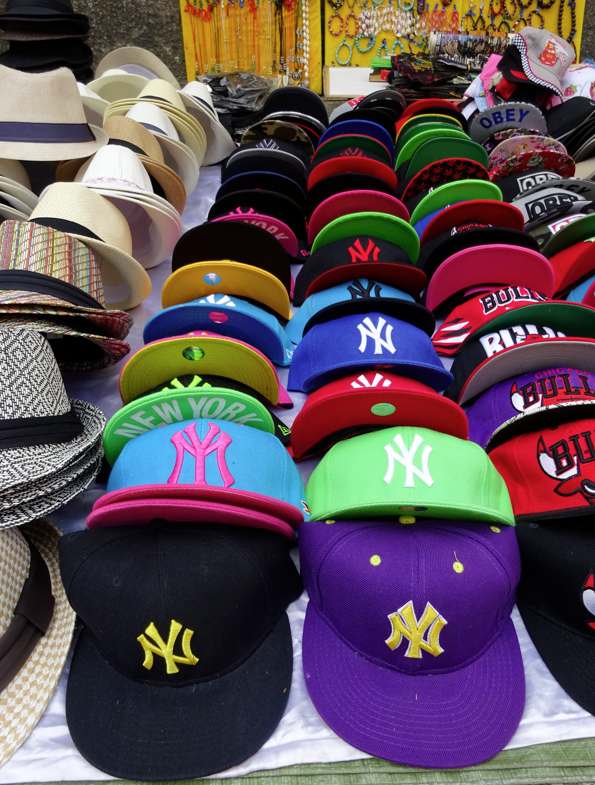
Yankee caps for sale in Lausanne, Switzerland. Right next to caps reading OBEY and BULL.
Sunday February 09, 2014
SLIDESHOW: Patricia and Erik's New York Adventure
Friday August 26, 2011
26 Things I Learned While Camping on San Juan Island and at Baker Lake
- The wrong time to get attacked by mosquitoes is two days before camping. Makes you sensitive to what you can't avoid.
- The 2008 Mazda 3 doesn't have a plug-in or outlet to charge iPhones.
- Washington State Ferrys do—but we figured it out too late. Thus no personal pictures here. Apologies.
- The San Juan ferry trip is 100 times better on a sunny day (returning) than on a cloudy day (going).
- San Juan Island has a camel. Her name is Mona. She has a baby. T-shirts are for sale.
- A camel is all well and good but it doesn't beat baby alpacas.
- If you go to Downriggers, in Friday Harbor, San Juan Island, spend the extra money for the dungeness crab sandwich. The grilled crab sandwich sounds like “grilled crab” but is actually a dollop of crab mixed with a gallon of mayonnaise and then the sandwich is grilled.
- Orca whales are actually dolphins.
- The skeletons of whale fins look like human hands.
- Dorsal fins are made of cartilage.
- Porpoises are shyer, smaller and chunkier than dolphins. They are nerds, essentially. Dophins are BMO-Seas. (Apologies.)
- Oceanographers are worried that boat noise, including noise from whale-watching boats, is depleting the whale population. Which is why we watched them from Lime Kiln Point State Park. Which may be why we didn't see any.
- The Whale Museum at Friday Harbor, where I learned #s 8-12, and which my nephews, 10 and 8, didn't want to leave after an hour, kicks ass.
- The scientists at Lime Kiln Point kick ass, too.
- Putting up a two-person tent is hard.
- Changing into your swimsuit in a two-person tent is harder.
- Changing into your swimsuit in a two-person tent, and getting a good look at your stomach, is a good way to get someone to go to pilates class next Wednesday at 5:30 PM.
- There are many multimillion-dollar yachts for sale at Roche Harbor, San Juan Island.
- The rich obviously need another tax break so they afford to buy these multimillion-dollar yachts and get our economy going again.*
- Yachta Yachta is a good pun but a bad name for a boat.
- Ryan, 8, likes rock climbing.
- Jordy, 10, knows the words to Sir Mix A Lot's “Baby Got Back.”
- Baker Lake is fucking gorgeous.
- A good brat beats a great hotdog.
- Patricia is freaked by worms. Even inchworms. Particularly inchworms that come down from trees on silk threads. She calls them “ninja worms.”
- The sign in park outhouses, advising against throwing garbage down toilets because “it is extremely difficult to remove,” is not only one of the most understated signs ever written, it also makes me think park employees are not paid nearly enough.

Baker Lake. We woke up to this. We went swimming in this. So can you. Because it's ours: a National Forest.
* Kidding.
Thursday June 09, 2011
Searching for Birds in Bodega, Calif.
If it's been a quiet week on ErikLundegaard.com it's because Patricia and I drove from Seattle to Bodega, Calif., for our friend Ward's 50th birthday. Ward lives in Seattle but his friends told him he had to do something special for his 50th; he couldn't just have a party. Initial discussions actually centered on Lebanon, but others reined in that thought and offered the Oregon coast. Bodega Bay was the compromise between the Oregon coast and Lebanon. As it always is.
My reaction upon hearing the party's location was the film nerd's reaction: You mean the place where Hitchcock filmed “The Birds”? I suggested all blondes attending wear their hair in a chignon.

Tippi Hedren demonstrating the chignon, which, oddly, is a masculine word in French.
We actually stayed a few miles south of Bodega Bay, at Dillon Beach, renting several houses with spectacular views of the ocean. Saturday morning, after the initial, intense warm-up dinner, with too many courses and too much wine, Ward convinced the entire crew to attend a charity pancake breakfast, then a mid-afternoon wine-tasting, but I begged off, not hungry, a bit hungover, and a whole lot curious about Bodega. I drove into town searching for ... I don't know what. That diner. That schoolhouse. Tippi Hedren.
The surroundings looked familar but not familiar enough, so I pulled over to the side of the road and read the Bodega Bay (pop 1423) section of Lonely Planet's Coastal California book. Apparently the place is “the first pearl in a string of sleepy fishing towns” and “the setting of Alfred Hitchcock's terrying 1963 avian horror fllck, The Birds” (I like the helpful addition of “avian” there), but as to what is where, the book wasn't much help. So I stopped in at the Terrapin Creek Cafe for a quick lunch and peppered the waitress with my “Birds” questions. She suggested the Visitor Center back on California 1, which runs through town, and which I'd passed on the way in. There, as soon as I mentioned “The Birds,” the woman behind the counter took out a single-sheet black-and-white map and a yellow highlighter, and in a tone somewhere between Selma Diamond and comatose, laid out the particulars:
- The Tides Wharf restaurant where everyone gathered during the attack
- The gas station that goes up in flames
- The house across the bay on Gaffney Point that never existed
- The Potter schoolhouse five miles south on California 1 in the town of Bodega; and
- The country store across the street that has the most extensive “Birds” collection anywhere in the world.
“I get the feeling you‘ve done this before,” I said. This brought a smile. “Only about eight thousand times a year,” she replied.
So I filled up my car at the gas station that blew up in “The Birds,” then drove across California 1 to the Tides Wharf Restaurant, where Tippi Hedren had watched in horror as the gas station blew up in “The Birds.” But the perspective still seemed off. The gas station was across California 1? On a hill? The Tides Wharf included a gift shop that barely mentioned “The Birds,” just—after a search—a few postcards, some lame T-shirts, a big picture book, and a smaller, almost mimeographed pamphlet called “The Birds by Hitchcock: Sonoma Coast Guide: Expanded Second Edition.” This last, I figured, you could only get there, so I got it there, then peppered the girls behind the counter with questions. One was a fount of information. The Tides Wharf where we were? Not the original. The original burned down in 1965, along with the gas station, which, yes, had been on this side of California 1. But the schoolhouse, the Potter Schoolhouse, still existed. Five miles south on “The 1.”
And that’s where I went. Here's the famous scene:

The Potter Schoolhouse attack in Alfred Hitchcock's “The Birds.”
In the town of Bodega, I initially mistook St. Theresa's Church, made famous by Ansel Adams, for the Potter Schoolhouse. But then I turned into a small road and there it was. It's privately owned now, and there's no bench in the backyard, let alone a playground or jungle gym; but I still got out and took a picture:

The Potter Schoolhouse today.
Then to the country store. As quiet as the rest of the town is about “The Birds,” the country store is just that noisy. It's like a museum but with all of the pieces for sale.

Apparently Tippi Hedren also sells wine now. Apparently she was in Bodega Bay the weekend before, at the Tides Wharf, signing autographs. I bought my share of swag—including a “What Would Hitchcock Do?” T-shirt—and acted the tourist. I just needed the Bermuda shorts and the camera hanging around my neck to complete the picture.
The next day, on the way out of town, Patricia and I returned to the schoolhouse to complete the picture:
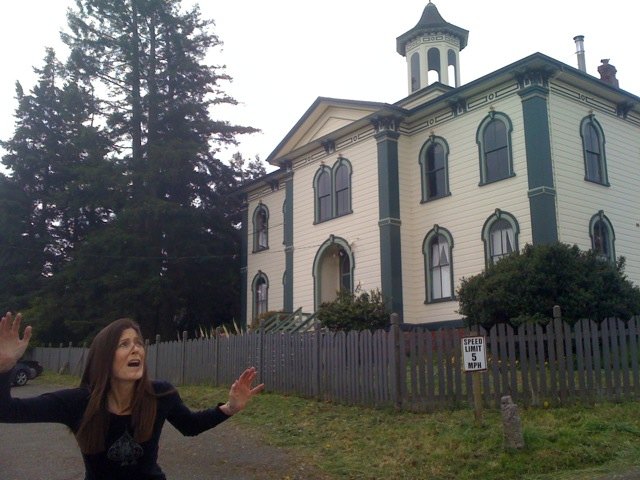
We'll photoshop the birds in later.
Wednesday June 08, 2011
California 1
Take a long drive with me
On California 1, California 1...
--The Decemberists, “California One/Youth and Beauty Brigade”
This past week, driving along California 1, the state route begun in 1934 that winds down the California coast, as Patricia and I traveled from Seattle to Bodega Bay for a friend's 50th birthday celebration, I kept thinking of baseball and pitching.
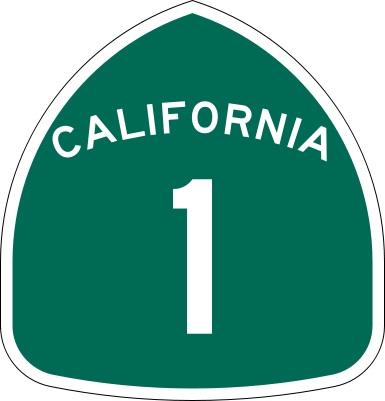 I know. Apologies, and bear with me.
I know. Apologies, and bear with me.
Most roads, certainly most highways, are like fastballs down the pike. They may have some bend in them but nothing you can't handle. California 1, in contrast, is like the craziest pitch thrown by the greatest pitcher ever. It twists and swoops and dips and soars and bends and keeps bending and keeps bending further until you're almost heading in the opposite direction—north when you want south, south when you want north—until, at last, it finally breaks the other way, your way, and the whole damn thing begins again.
And the speeds! A good freeway may vary its speeds a bit, like a good pitcher will vary his speeds between the 95-mph fastball, the 85-mph splitter and the 75-mph change-up. These differences are nothing on California 1. There, you'll be spotted 55 mph. Then with hardly a warning it'll cut back to 15 mph. Back up to 45. Down to 25. Then 15 again. Then back up to 55. All on these swooping, dipping, winding roads, with incredible views of sky and ocean, cliffs and haystack rocks, and you're so distracted by it all, by the beauty and the winding roads, you find yourself going 55 in the 15 zone, 15 in the 55 zone.
But worth it. We can't wait to go back.
Wednesday June 08, 2011
Bumper Stickers Seen Driving From Seattle, Wa. to Bodega, Ca.
WHY IS THERE ALWAYS MONEY FOR WAR BUT NOT FOR EDUCATION?
—Olympia, Wa.
FOLLOW ME TO DRIVE-THRU FEED
—Chehalis, Wa.
GOD DANCED THE DAY YOU WERE BORN
—Salem, Wa.
KILL FACEBOOK
—Portland, Or.
MY OTHER CAR IS A DRAGON BOAT
—Harrisburg, Or.
TRY JESUS
—Lorane, Or.
LAND OF THE FREE/ BECAUSE OF THE BRAVE
—Fortuna, Ca.
ARNOLD DON'T SURF
—Mendecino, Ca.

Patricia, Dairy Queen, and Hwy 101 during a rare sunny moment on our trip.
Monday September 27, 2010
Travels: Rehoboth Beach: Lessons in Capitalism
I fear I didn’t capture Rehoboth right here. I fear I didn’t capture our week in Rehoboth right. I missed so much. For example:
- Rehoboth’s summertime workers used to be populated by Mid-Atlantic kids like my sister, from Timonium, Md., but now they’re more often from the former Soviet Union: Russia and Belarus and Ukraine. I brought this up with the owner of the house my sister was renting, who lived next door and popped in on us one evening, big-voiced and garrulous and fun, with the thickest of Delaware accents, as we were all drinking and talking on the screened-in front porch. He assumed I was
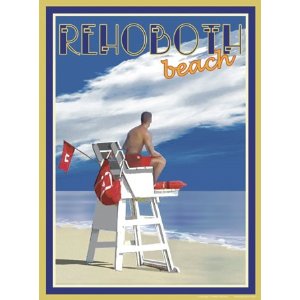 referencing a prostitution ring that made headlines in the mid-1990s but I said I didn’t know from prostitution rings. It’s the geography of it. Why Russia? Why not, you know, Timonium? I forget his response. He might have repeated the line I’d heard from others: that summer vacation in Eastern Europe tends to go on longer than ours, and so the Russian kids can stay past Labor Day and not leave businesses short-staffed for the final weeks of the season. That made sense to me. Until I spoke with a girl from Russia I met at the Internet Cafe on 1st Avenue, who, while answering a slew of questions (“Had she been to other cities?” Yes. “Favorite?” Miami. “How did she hear about the Rehoboth job?” There was a company in Russia, who worked with a company in America, who...), added, unbidden, that the tough part of the deal was getting back to Russia two weeks after her Russian school started. Summer vacations aren’t different. The difference between then and now is who bears the burden of the overlap. It used to be Americans businesses, who remained short-staffed while American kids returned to school. Now it’s the Russian kids, who remain in America while their Russian peers get a leg-up. Welcome to capitalism.
referencing a prostitution ring that made headlines in the mid-1990s but I said I didn’t know from prostitution rings. It’s the geography of it. Why Russia? Why not, you know, Timonium? I forget his response. He might have repeated the line I’d heard from others: that summer vacation in Eastern Europe tends to go on longer than ours, and so the Russian kids can stay past Labor Day and not leave businesses short-staffed for the final weeks of the season. That made sense to me. Until I spoke with a girl from Russia I met at the Internet Cafe on 1st Avenue, who, while answering a slew of questions (“Had she been to other cities?” Yes. “Favorite?” Miami. “How did she hear about the Rehoboth job?” There was a company in Russia, who worked with a company in America, who...), added, unbidden, that the tough part of the deal was getting back to Russia two weeks after her Russian school started. Summer vacations aren’t different. The difference between then and now is who bears the burden of the overlap. It used to be Americans businesses, who remained short-staffed while American kids returned to school. Now it’s the Russian kids, who remain in America while their Russian peers get a leg-up. Welcome to capitalism. - My nephew Ryan couldn’t get enough of Funland. Not the rides but the games. And not the games but the prizes from the games. He loves stuffed animals. As soon as he won one he wanted another, and as soon as he won a small one he wanted a bigger one. Funland allows you to trade up this way: three smalls equal a medium; three mediums equal a bigger medium. The big prize was a giant stuffed alligator. He was all id—want, want, want—and no army of stuffed animals sated his desire. We talked of having an intervention but we acted as enablers. Yes, Ryan, one more game. Sure, Ryan, I’ll play with you since it’s 11 in the morning and no one else is at Wac-a-Mole. At the end of the week, his mother, my sister Karen, showed up at lunch with the giant stuffed alligator under her arm. But she hadn’t won it. She’d run into the owner of Funland, for whom she worked back in the 1980s, and he gave it to her. Another lesson in capitalism: It’s who you know.
- Ryan’s older brother, Jordy, didn’t want stuffed animals; he wanted stuff: electronics, mostly. He’s a gamer, with earlier versions of PlayStation and current versions of Wii at home, and one night, at the Surfside Arcade, he played the arcade version of “Guitar Hero,” which he has on the Wii, and did so well with Foghat’s “Slow Ride” (on “hard”) that he drew an audience, to whom, like a real rock star, he was oblivious. He wound up with the fifth-best score, just ahead of someone calling himself “Slash.”
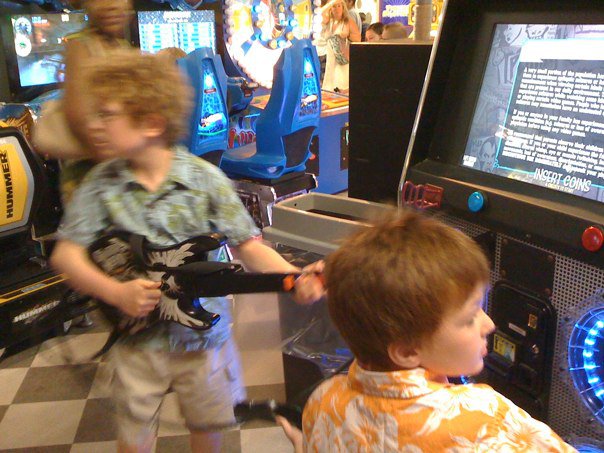
- Two of my favorite swims at Rehoboth were early-morning, solo swims after jogs along the boardwalk. There’s nothing like diving into the ocean still sweating and steaming from a run. There’s nothing like a swim before breakfast with only beachcombers and sand zambonis around. That’s living. That’s fun.
- Mostly we ate in, lovely meals over at the Muschlers’ rental home, sitting in the backyard, drinking and talking, as the light died and the bugs came out. We went out for dinner twice: once to Obie’s By the Sea, just off Olive on the north end of the boardwalk, and once to Ed’s Chicken & Crab in Dewey, where my mother and sister, who ignore the chicken part of the equation, closed the joint.
- But my favorite meal may have been the one we had before we arrived. My mother had picked up Patricia and I at 9:30 a.m. at Reagan National, and we sped over the Bay Bridge before 11:00, which for Patricia and I was 8:00, so we weren’t interested in the sea food restaurant just on the other side that my sister had recommended. But once it was after noon, where to eat? We drove along 404 toward Rehoboth, seeing a few spots, but momentum kept carrying us on until finally, at a county junction, Patricia yelled, “That place!” and I stopped the car and turned into the gravel parking lot. It was a Kiwanis Club barbecue chicken joint, open-aired but covered, where you ate at picnic tables and used a water pump to wash your hands afterward. A line of women were serving up the following: half a chicken, sweet pickles, a roll and bag of potato chips. That chicken turned out to be the best barbecue I’ve had in years: tangy and juicy. I also had a great encounter at the end of the line, where you paid, and where a tip jar stood for donations to the Bridgeville Center. I looked at the cashier, a man in his 70s, and pointed. “What’s the Bridgeville Center?” I asked. He seemed surprised, first, that a question had been asked, then leaned forward conspiratorially. “It’s just a buncha old farts,” he said. I gave him a dollar for the laugh.
And on and on. I could add more, but I don’t think I’ll be able to capture what I really want to capture about Rehoboth Beach. It may be as simple as the heat on the wood of the boardwalk; it may be as complex as the sense of fulfillment you have in the ocean, or the sense of longing you have out of it. Besides, I know I’m lingering. I know it’s Saturday morning. Time for one last walk to the boardwalk. Time for one last look at the ocean.

Sunday September 26, 2010
Travels: Rehoboth Beach, Del.: Going Back from Whence We Came
In the end it’s all about the beach.
My father used to say there was nothing like that first dip in the ocean after the long, hot, sweaty haul to get there, but this never made sense to me. It was just another odd thing grown-ups said. Now I’m that grown-up.
Our long, sweaty haul started on a Friday at 9 p.m. in Seattle and lasted through a red-eye to Chicago, a 6 a.m. flight to D.C., a morning car trip over the Bay Bridge and through eastern Maryland and into Delaware, with a few wrong turns along the way, until we crawled, in the mid-afternoon heat, along Highway 1, with all of the other Saturday arrivals, before making that final, impatient, left-hand turn onto Rehoboth Avenue and into the offices of Jack Lingo Real Estate to collect the keys, and into the Lingo’s grocery store to collect the weekend necessities, and over to Mom’s place to drop off her stuff, and over to our place to drop off our stuff, and then the two-block trip back to Mom’s place to drop off her car—but not before being confronted by a cop who asked why I’d parked a quarter into someone’s driveway (there’d been a neighborly complaint), and I explained that it was temporary, that we were staying in that small cottage at the back of the driveway there, and this was my first time in Rehoboth in 25 years, and, hey, how old are you anyway?, which got him to smile and admit, “Twenty-one” and merely issue me, 26 years his senior, a warning—and after all that it was 5:00 and the sun was lowering in the sky, but I didn’t care and changed into swimsuit and flip-flops and grabbed a towel and walked the half block to the boardwalk and over the hot sand and through the departing crowds and dropped everything by the driest part of the high-tide mark and stepped into the cool, salty water, feeling the spray and hearing sizzle of the waves, and in past my calves and thighs and, oof, groin, until I dove into a wave and rose on the other side, and thought, as the ocean washed away the day of travel, the month of troubles, the year of work, “Dad was right.”
Why does it feel so good? Because it’s the water we emerged from? Because we ourselves are salt and water? It feels heavier than most water, cooler than most water, and the waves provide their own challenge. The ocean doesn’t automatically accept us, like other, more placid bodies of water. It’s trying to expel us even as it tries to pull us in further. It has mixed feelings. I floated on my back, watched my toes emerge, and felt lucky.
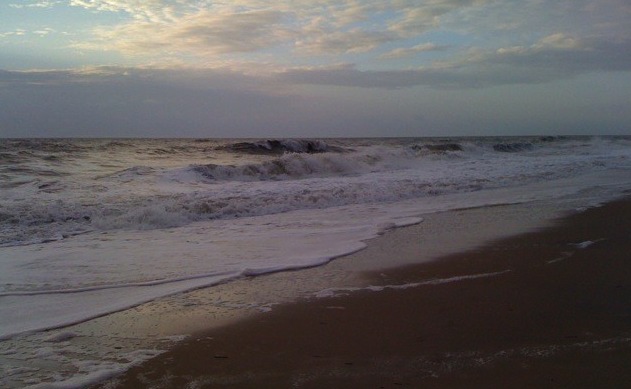
My sister, Karen, set up the vacation. Her husband, Eric, is a Muschler, and every year three of the Muschler boys and their families vacation somewhere for a week, which allows parents to get together and all of the various cousins to create havoc together, and this year Rehoboth was chosen because it’s where our family vacationed in the 1970s, and where Karen worked during high school and college summers in the 1980s. The Muschlers rented a big house on Stockley Avenue (pronounced Delawarean: “Stow-klee”), two and a half blocks from the beach; then she asked if Patricia and I wanted to come along. Normally we vacation in fairly exotic spots—Little Corn Island, Nicaragua; Hanoi, Vietnam—but I was in the mood for a less exotic spot. I wanted a place with cotton candy.
We rented our own cottage, also on Stockley Avenue, but a half block from the beach. The online photos were vague, which had me worried, but we found it charming enough: living room, small kitchen, separate bedroom, bath. There was even a back deck where we locked up the bikes that we rented for the week. The back deck was also where the Muschlers stored most of our beach gear—chairs and umbrellas—so they wouldn’t have to keep carting them the extra two blocks every morning. Or afternoon.
The Muschlers tend to be late risers—or, with so many kids, late goers—so we were rarely at the beach early. Sometimes we arrived around 11:00, which didn’t make much sense in the “danger danger danger” UV-ray world of 2010; other times we avoided the morning altogether and showed up around 2:00 and made an afternoon of it.
My nephew, Jordy, 9, took to the waves like a champ. Whenever he was at the beach, he was in the water: diving into the waves, riding the waves, wondering why the waves weren’t bigger. His brother, Ryan, 7, took to the sand like a champ. He wanted to bury and be buried. Who doesn’t want to be at the beach? One day, my mother, 80, put on a swimsuit and dipped her toes, too.
My favorite day was our last full day. On Thursday, Rehoboth was drenched with two big rainstorms: one in the early afternoon that cleared the boardwalk; one in the late evening as we sat, protected, at Ed’s Chicken & Crab joint in Dewey, and watched people run in breathless and soaked from the downpour and the flash-flooding in the streets. As a result, there was a freshness to everything Friday morning as Patricia and I took our coffee and went for an early-morning, barefoot stroll by the ocean. The waves were bigger than usual, but overall it seemed like a normal morning.
We’d decided on a bike ride that morning. Several days earlier, on a misty Monday morning, we’d scoped out the area north of Rehoboth—Henlopen Acres, where the rich folks lived, and Gordon Pond Wildlife Area, where the frogs lived—so Friday morning we headed south, past Silver Lake, but quickly got caught between small neighborhoods and Highway 1, as Delaware, a narrow state already, narrowed to a thin peninsula, and didn’t allow us much space. Eventually we doubled back. The bike rental place, Bike to Go, had given us a brochure that included, along with the oddest of quotes (“Nothing compares to the simple pleasure of a bike ride.” — President John F. Kennedy), the seven best rides in the area. We’d kind of done #s 1 and 2 already, and #4 was what we’d just avoided, but #5, the Junction & Breakwater Trail, had been recommended not only at the rental place but by our neighbor, a friendly, newbie lawyer from New England. He said the trail paralleled Hwy 1 but went through quiet woods and marshlands and neighborhoods and wound up in Lewes, the town north of Rehoboth.
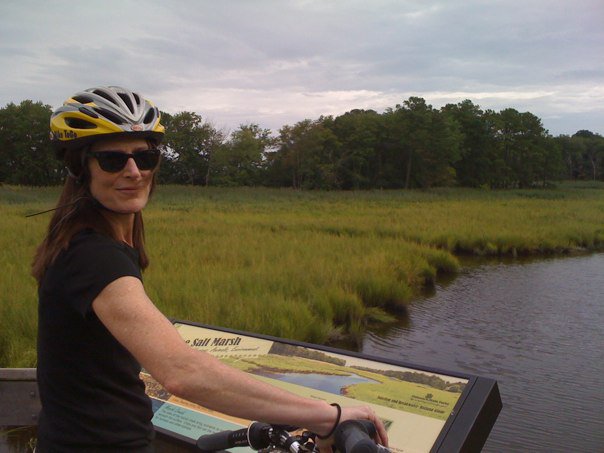
Patricia before the crash.
Patricia and I have different paces, though—I bike all the time, she seldom—and four miles along on the wide trail, in the middle of sparse woods, I realized I was too far ahead and stopped and waited. And waited. Finally I doubled back to find Patricia standing sheepishly by her bike. She gestured impotently. I assumed a flat but it wasn’t a flat. She’d been biking along, close to a fence, then experienced that odd sensation of being pulled into the very thing she was trying to avoid. Crash. She scraped her arm, bent her back tire, and now the back tire wouldn’t turn. The best I could do was release the back brakes so the tire would at least turn and she and I could hobble back to Rehoboth. Initially I was bummed—all that way without Lewes—but it turned out for the best.
After refueling at a co-op on Delaware Alt 1, and returning our bikes to the bike rental shop (had I spent the $5 on insurance last Sunday...? I had! Ka-ching!), we walked over to Dolles on the boardwalk to buy salt water taffy for the folks back home.
And that’s when I noticed the waves.
They were huge. How huge? In our absence the waves had come up almost to the boardwalk, and there were warm, stagnant pools of water on the beach proper, where adults pulled small kids around on boogie boards. It felt like an event. I immediately called Karen.
Half an hour later, Eric Muschler, Jordy, and I, were all trying to find a way to navigate into the water. Foam slopped everywhere. Few people were in the water but the pull to be in the water was as strong as any undertow. This was where it was happening and I wanted to be in it as it was happening. But how? I’d get out knee deep and a wave that had broken 10 feet in front of me still rumbled with enough force that, even bending beneath it, it would still push me a few feet closer to shore. Then I’d trudge back out again. In this way we danced. One time the wave broke late, right in front of me, and, even diving beneath it didn’t help. I was yanked off my feet and pushed and somersaulted to shore, where an awestruck, soaked Jordy stood watching.
“Poseidon is angry today,” he said.
I needed 10 more feet of courage. Eric had it, and went out beyond the breaking waves and sometimes rode them in, like bucking broncos. But the ocean out there seemed so deep and roiling and chaotic that I didn’t have that extra 10 feet of courage.
Instead, for an hour, I stood in the midway point, in the worst place you could possibly stand, and engaged in a shoving match with the ocean that the ocean always won. It was glorious.

Eric Muschler, Jordy and I and the “No Swimming” warning flag on our last day at the beach.
Thursday September 23, 2010
Travels: Mourning in Rehoboth
Read the intro here. Read Pts. II (mini-golf) and III (tea shirts) here and here.
But the biggest change may not have been in Rehoboth; it may have been in me.
A few years ago, MSNBC-Movies asked me to write a piece about the 10 Sexiest Women, by which they meant actresses, and in the intro I explained what I did and didn’t mean by “sexy.” Mostly I didn’t mean young girls. I said women tend to get sexier as they age. I wrote:
Sexy is balance. Cool and hot at the same time. Interest and disinterest. It’s not passive but it’s not in a hurry either. It seems to arrive at that moment in a woman’s life when she’s still hot but can no longer rely on it completely. Or maybe it arrives when a woman decides to take charge. Or maybe I just like women taking charge.
All of which is still mostly true. Yet walking on the boardwalk, walking on the beach, passing by girls in their early 20s, or late teens, or, God help me, younger, wearing barely anything at all, well, I’ve never felt like such a dirty old man.
Another old man, a wiser old man, the one in Richard Linklater’s film “Slacker,” says, “When young, we mourn for one woman... as we grow old, for women in general,” and that was me when young, and that was me along the boardwalk last month. Maybe when young we mourn for one woman because she’s the one we can’t have, and as we age we can’t have any of them so we mourn for them all. Maybe 30 years ago the boardwalk at night was the place where I yearned for romance and didn’t find any, so I still carry that adolescent emotion within me as I near 50. Maybe the boardwalk at night is simply a place of yearning.
It’s also a place for sublimation. Here is all you can’t have, walking by in the other direction, so why not take out your frustrations on this video game? Why not let this Funland ride spin your frustrated body ’round and ’round? Why not stuff your face? That week I must have had five or six Kohr’s soft-serve ice cream cones and thought nothing of it, but, from a distance, the writer in me balks at the obvious symbolism. “Really, Erik. Ice cream? Could you be more obvious?”
This is part of the inherent contradiction of Rehoboth. Every empire carries within it the seeds of its own destruction, and while the empire of Rehoboth offers the hard bodies of young men and women parading along the boardwalk, it also offers, to these hard bodies, hot dogs and submarines and hamburgers and french fries and fried chicken and pizza and gyros and cheesesteaks and crabcakes and fudge and salt-water taffy and popcorn and ice cream. Something’s gotta give. In his essay, “The Art of Donald McGill,” George Orwell writes about the bad jokes in the twopenny postcards in the cheap stationers’ windows in 1940s London, and dissects a necessary component of these jokes:
Sex-appeal vanishes at about the age of twenty-five. Well-preserved and good-looking people beyond their first youth are never represented. The amorous honey-mooning couple reappear as the grim-visaged wife and shapeless, moustachioed, red-nosed husband, no intermediate stage being allowed for.
I kept thinking of these lines all week. Intermediate stages happen, of course—you see healthy people in their 40s and 50s and 60s—but Rehoboth is all about celebrating youth even as it offers every fat, greasy, sugary thing to destroy youth. In the end it’s a short step from being a young girl on the boardwalk parading by in her bikini, the world at her feet, to being the overweight mom on the bench, rocking the stroller, the world passing her by.
Maybe this is why, as we age, we mourn for women: less for our lost youth than for theirs.

All previous entries
Baseball's Active Leaders, 2023
What Trump Said When About COVID
Recent Reviews
Everything Everywhere All at Once (2022)
Black Panther: Wakanda Forever (2022)
Doctor Strange in the Multiverse of Madness (2022)
Spider-Man: No Way Home (2021)
The Cagneys
A Midsummer Night's Dream (1935)
Something to Sing About (1937)
Angels with Dirty Faces (1938)
A Lion Is In the Streets (1953)
Man of a Thousand Faces (1957)
Never Steal Anything Small (1959)
Shake Hands With the Devil (1959)








